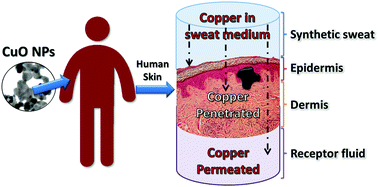CuO nanoparticle penetration through intact and damaged human skin†
Abstract
The great antimicrobial action of copper oxide nanoparticles (CuO NPs) and their consequent use in many applications in the biomedical field have caused concern about the potentially negative effects of human skin exposure to CuO NPs. However, so far, very few studies have investigated the toxic action of CuO NPs toward humans, with a special focus on the skin penetration route of entry. This study considers for the first time the absorption of topically applied CuO NPs through the human skin, using a Franz static diffusion cell model. We characterised the colloidal behaviour and static dissolution of commercial bare CuO NPs, evaluating both intact and damaged skins. We tested physiological solutions as the receiving phase; as the donor phase, CuO NPs were dispersed in synthetic sweat and exposed to the outer surface of the skin (0.11 mg cm−2) for 24 hours. The Cu elemental analysis in the receptor fluid and in the exposed skin allowed us to quantify the copper translocation within the epidermis and dermis. The experimental data showed that the CuO NPs absorption through intact skin was negligible. However, in damaged skin, we observed an increasing permeation of copper. The latter would justify the capacity of CuO NPs to pass the first skin layers and release Cu2+ ions into the stratum corneum, reaching the receptor fluid in the in vitro diffusion cell system.



 Please wait while we load your content...
Please wait while we load your content...